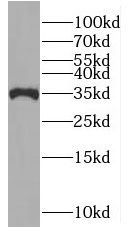Products
MUL1 antibody
| Synonyms: | Mitochondrial ubiquitin ligase activator of NFKB 1|E3 SUMO-protein ligase MUL1|E3 ubiquitin-protein ligase MUL1|Growth inhibition and death E3 ligase|Mitochondrial-anchored protein ligase|Protein Hades|Putative NF-kappa-B-activating protein 266|RING finger protein 218|RING-type E3 ubiquitin transferase NFKB 1|MUL1|C1orf166|GIDE|MAPL|MULAN|RNF218 antibody | ||
| Catalogue No.: | FNab05435 | Reactivity: | Human, Mouse, Rat |
| Host: | Rabbit | Tested Application: | ELISA, IHC, WB |
| Clonality: | polyclonal | Isotype: | IgG |
| Size | Price |
|---|---|
| 100µg | Inquiry |
- SPECIFICATIONS
- FIGURES
- CONDITIONS
- FAQS
- Product Name
- MUL1 antibody
- Catalogue No.
- FNab05435
- Size
- 100μg
- Form
- liquid
- Purification
- Immunogen affinity purified
- Purity
- ≥95% as determined by SDS-PAGE
- Clonality
- polyclonal
- Isotype
- IgG
- Storage
- PBS with 0.02% sodium azide and 50% glycerol pH 7.3, -20℃ for 12 months(Avoid repeated freeze / thaw cycles.)
- Immunogen
- mitochondrial E3 ubiquitin ligase 1
- Alternative Names
- Mitochondrial ubiquitin ligase activator of NFKB 1|E3 SUMO-protein ligase MUL1|E3 ubiquitin-protein ligase MUL1|Growth inhibition and death E3 ligase|Mitochondrial-anchored protein ligase|Protein Hades|Putative NF-kappa-B-activating protein 266|RING finger protein 218|RING-type E3 ubiquitin transferase NFKB 1|MUL1|C1orf166|GIDE|MAPL|MULAN|RNF218 antibody
- UniProt ID
- Q969V5
- Observed MW
- 35 kDa
- Tested Applications
- ELISA, IHC, WB
- Recommended dilution
- WB: 1:500-1:2000; IHC: 1:20-1:200
 Transfected HEK-293 cells were subjected to SDS PAGE followed by western blot with FNab05435(MUL1 Antibody) at dilution of 1:1000
Transfected HEK-293 cells were subjected to SDS PAGE followed by western blot with FNab05435(MUL1 Antibody) at dilution of 1:1000
 Immunohistochemistry of paraffin-embedded human kidney using FNab05435(MUL1 antibody) at dilution of 1:50
Immunohistochemistry of paraffin-embedded human kidney using FNab05435(MUL1 antibody) at dilution of 1:50
- Background
- Exhibits weak E3 ubiquitin-protein ligase activity. E3 ubiquitin ligases accept ubiquitin from an E2 ubiquitin-conjugating enzyme in the form of a thioester and then directly transfer the ubiquitin to targeted substrates. Can ubiquitinate AKT1 preferentially at 'Lys-284' involving 'Lys-48'-linked polyubiquitination and seems to be involved in regulation of Akt signaling by targeting phosphorylated Akt to proteosomal degradation. Proposed to preferentially act as a SUMO E3 ligase at physiological concentrations. Plays a role in the control of mitochondrial morphology. Promotes mitochondrial fragmentation and influences mitochondrial localization. The function may implicate its ability to sumoylate DNM1L. Inhibits cell growth. When overexpressed, activates JNK through MAP3K7/TAK1 and induces caspase-dependent apoptosis. Involved in the modulation of innate immune defense against viruses by inhibiting DDX58-dependent antiviral response. Can mediate DDX58 sumoylation and disrupt its polyubiquitination.
How many times can antibodies be recycled?
First, usually it's not suggested to recycle antibodies. After use, buffer system of antibodies has changed. The storage condition of recycled antibodies for different customers also varies. Thus, the performance efficiency of recycled antibodies can’t be guaranteed. Besides, FineTest ever conducted the antibody recycling assay. Assay results show recycling times of different antibodies also varies. Usually, higher antibody titer allows more repeated use. Customers can determine based on experimental requirements.
Notes: After incubation, we recycle rest antibodies to centrifuge tube and store at 4℃. High titer antibodies can be stored for a minimum of one week. Reuse about three times.
What are components of FineTest antibody buffer?
Components of FineTest antibody buffer are usually PBS with proclin300 or sodium azide, BSA, 50% glycerol. Common preservative is proclin300 or sodium azide, which is widely applied in the lab and industry.
How about the storage temperature and duration of FineTest antibodies?
Most antibodies are stored at -20℃. Directly-labeled flow cytometry antibodies should be stored at 2 - 8℃. The shelf life is one year. If after sales issues for purchased antibodies appear, return or replacement is available. Usually, antibodies can be still used after the one-year warranty. We can offer technical support services.
Is dilution required for FineTest antibodies? What’s the dilute solution?
Directly-labeled flow cytometry antibodies are ready-to-use without dilution. Other antibodies are usually concentrated. Follow the dilution ratio suggested in the manual. Dilute solution for different experiments also varies. Common antibody dilution buffers are acceptable(e.g. PBST, TBST, antibody blocking buffer).
How to retrieve antibodies for immunohistochemistry?
Common retrieval buffers: Tris-EDTA Buffer(pH 9.0); Citrate Buffer(pH 6.0)
Heat induced antibody retrieval:
Method 1: Water-bath heating: Put the beaker with retrieval buffer and slide in the boiling water bath. Keep the boiling state for 15min. Naturally cool to room temperature;
Method 2: Microwave retrieval: Put the beaker with retrieval buffer and slide in the microwave oven. Heat at high power for 5min, Switch OFF for 3min, Heat at medium power for 5min. Naturally cool to room temperature.
How to choose secondary antibodies?
(1) Secondary antibodies react with primary antibodies. Thus, secondary antibodies should be against host species of primary antibodies. E.g. If the primary antibody is derived from rabbit, the relevant secondary antibody should be against rabbit. E.g. goat anti rabbit or donkey anti rabbit.
(2) Choose secondary antibody conjugates according to the experimental type, e.g. ELISA, WB, IHC etc. Common enzyme conjugated secondary antibodies are labelled by HRP, AP etc. Fluorescin or dye labelled secondary antibodies are applied in immunofluorescence and flow cytometry(e.g. FITC, Cy3).
